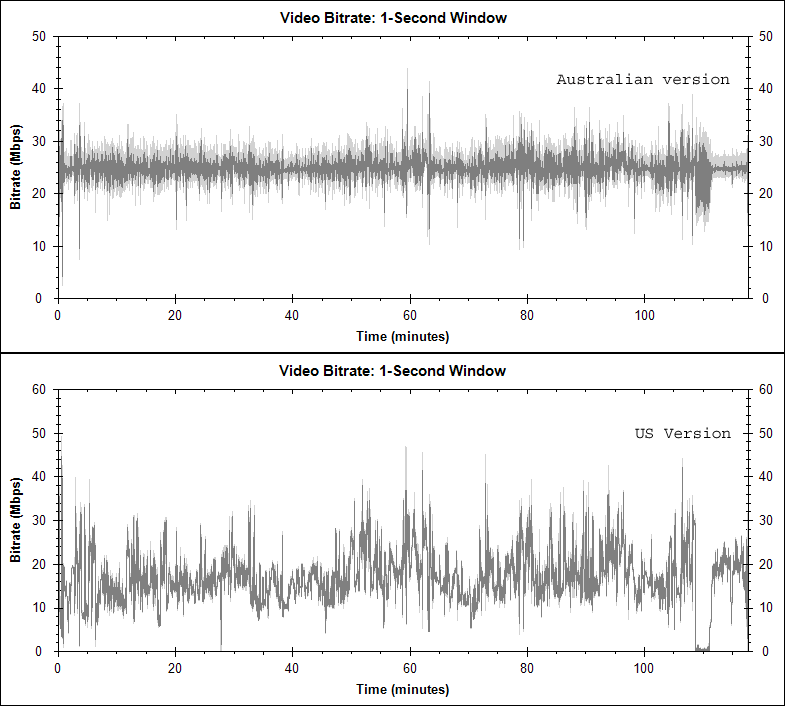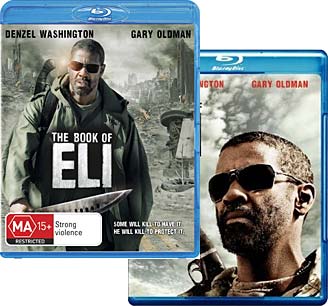

The US Warner Bros version employs the VC1 codec at the remarkably modest average bitrate of just 16.957Mbps. The Australian Sony version uses MPEG4 AVC at 24.931Mbps. These figures and the bitrate graphs shown below were derived using the excellent BDInfo analysis program.
As you can see from the graphs below, not only were the average bitrates very different, so was the encoding strategy. Both used a variable bitrate, with the bits allocated changing depending upon the requirements of the scene (sharper, more detailed scenes require more data, as do fast moving sections of action). But it is clear that the US version varies the birate very much more aggressively than the Australian version.
Unlike the earlier comparison I prepared, the movie versions are the same and, as we shall see, there simply isn't anything obvious in the way of colour, focus or other differences between the frames to suggest that, video encoding aside, anything else differs between the two versions. Indeed, I wouldn't be at all surprised if both were derived from an identical uncompressed digital video master.
As comparison material, this movie is somewhat limited. It clearly uses a highly processed and substantially desaturated colour palette. Nonetheless the Australian version at least looks fine on the big screen.
The overall average video bitrates don't tell you anything about the detail, so here are the detailed scans (note, the vertical scales are different):

Clearly the Australian Sony version wastes a lot of bits. The US version just about bottoms out for a couple of minutes around 110 minutes. This is the beginning of the credits where the major ones are flashed up as still shots and maintained for several seconds, requiring very little data to present accurately. Yet this same section on the Australian version chews up 25Mbps for very little purpose.
Still, the question is whether the clearly higher average video bitrate in the Sony version (or the codec) affects the picture quality. Can we tell the difference?
The comparison frames below were generated by ripping from the disc to *.png format. The US frames were ripped by Cinema Squid, the Australian ones by me. This format is compressed, but not lossily. I have made no edits at all to the frames.
How to do it
Each pair of frames is contained in a Zip file, and you can download the ten zip files below (in Windows, right click and choose 'Save As ...'; in other OSs, you know how).
Download all ten, unzip them and compare the 'A' and 'B' versions of the frame. I randomised* them, so some of the US Warner version frames are 'A' and some are 'B', and likewise for the Australian Sony version.
Decide which you think is which and email me a simple response as follows:
Frame 1: A Sony, B Warner Frame 2: B Sony, A Warner Frame 3: A Sony, B Warner Frame 4: B Sony, A Warner Frame 5: A Sony, B Warner Frame 6: B Sony, A Warner Frame 7: A Sony, B Warner Frame 8: B Sony, A Warner Frame 9: A Sony, B Warner Frame 10: B Sony, A Warner(No, that isn't the answer!) Email me by clicking on this link, then copying the above block into the email and, of course, changing the As and Bs to what you think the answer is.
Please don't send more than one.
This is not a proper scientific test of the kind from which firm actionable conclusions could be drawn. However it will yield some information, mostly about you the readers and participants.
THIS IS IMPORTANT: If for whatever reason you cannot tell one or more of them apart, please email me anyway! In the relevant Frame slot, just put 'Dunno', or something of similar meaning. While not all that scientific, it will be one hell of a lot less scientific if the unknowns are omitted.
I shall email back to you the correct answer after a week or so.
Now let's see how you go!
| Frame
Number | Frame location (h:mm:ss) | Thumbnail | Download (right click and choose 'Save As ...') |
|---|---|---|---|
| 1 | 00:02:52 | 
| Download (3.48 MB) |
| 2 | 00:05:33 | 
| Download (3.23 MB) |
| 3 | 00:18:04 | 
| Download (3.75 MB) |
| 4 | 00:18:57 | 
| Download (3.80 MB) |
| 5 | 00:19:55 | 
| Download (3.85 MB) |
| 6 | 100:21:55 | 
| Download (3.56 MB) |
| 7 | 00:27:04 | 
| Download (2.92 MB) |
| 8 | 00:50:27 | 
| Download (3.14 MB) |
| 9 | 01:13:33 | 
| Download (3.65 MB) |
| 10 | 01:36:32 | 
| Download (3.85 MB) |
Last updated: 5 January 2010